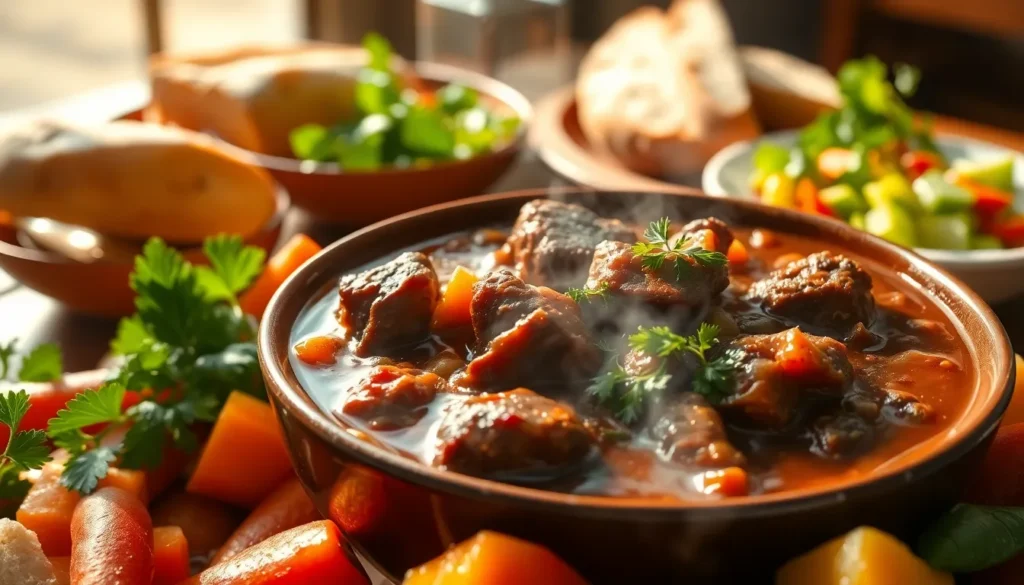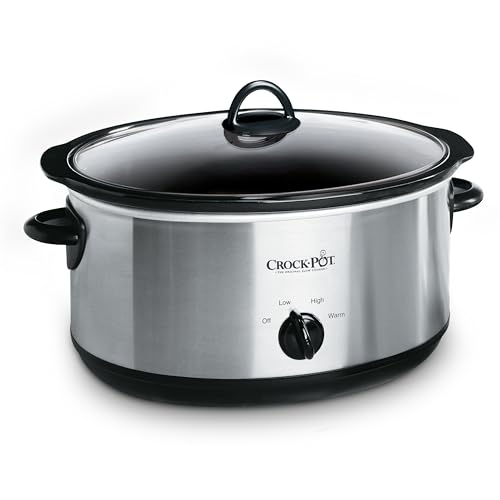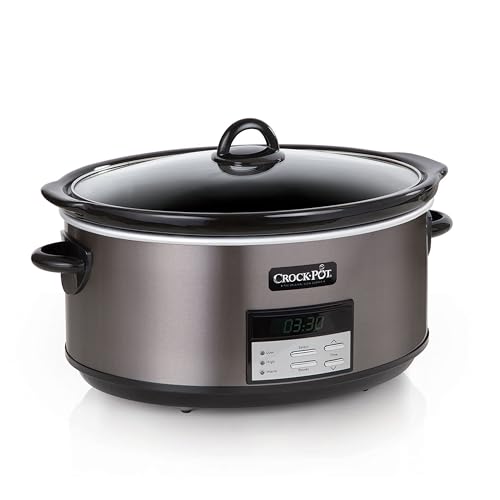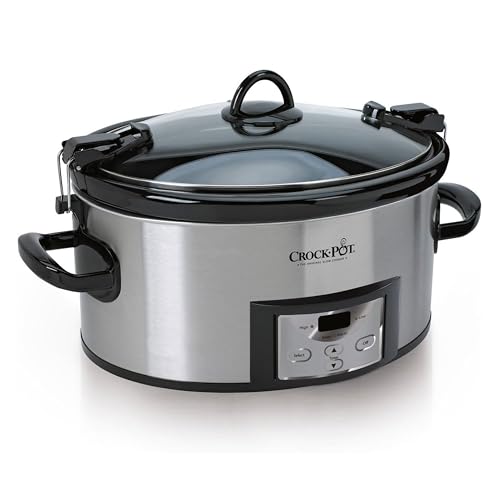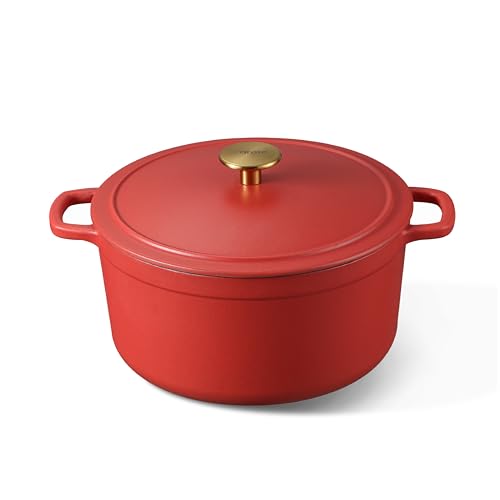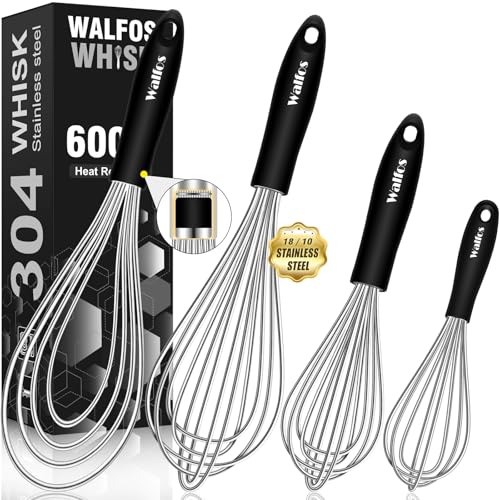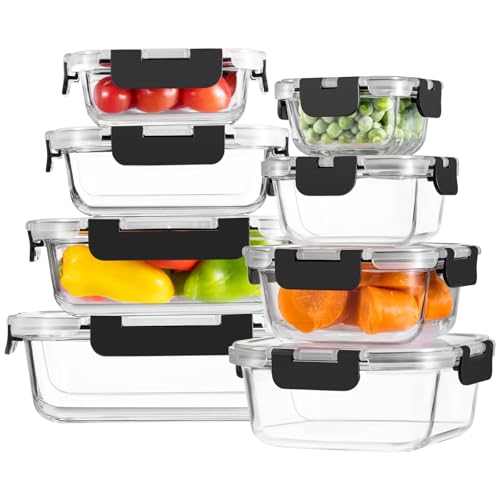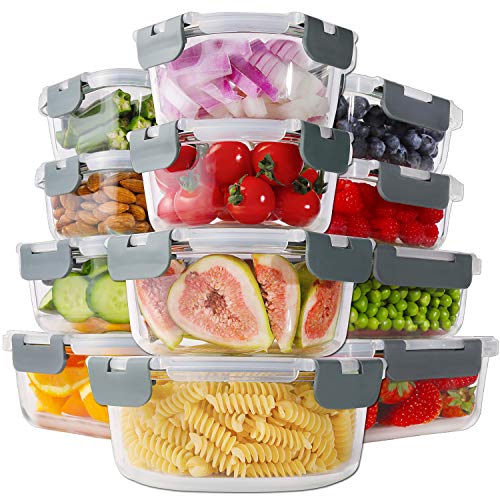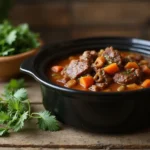When cold weather hits and we’re craving ultimate comfort food, nothing beats a hearty bowl of beef stew made with McCormick’s signature seasoning blend. This time-tested recipe transforms simple ingredients into a soul-warming masterpiece that’s been satisfying families for generations.
We’ve perfected this classic using McCormick’s expertly crafted spice mix, which eliminates the guesswork of seasoning while delivering restaurant-quality flavor every single time. The tender chunks of beef, perfectly cooked vegetables, and rich savory broth create a meal that’s both elegant enough for guests and comforting enough for weeknight dinners.
What makes this beef stew truly special is how the McCormick seasoning blend brings out the natural flavors of each ingredient while adding that distinctive depth we all love. Ready in just a few hours with minimal prep work, this recipe proves that incredible homemade meals don’t have to be complicated.
Ingredients
We’ve carefully selected each ingredient to work harmoniously with McCormick’s signature seasoning blend. Our recipe combines premium beef cuts with fresh vegetables and aromatic spices to create the perfect foundation for this beloved comfort dish.
Beef and Main Proteins
- 2 pounds beef chuck roast, cut into 2-inch cubes
- 2 tablespoons all-purpose flour
- 2 tablespoons vegetable oil
- 1 tablespoon butter
Vegetables
- 3 large carrots, peeled and cut into 1-inch pieces
- 3 celery stalks, chopped into 1-inch pieces
- 1 large yellow onion, diced
- 3 medium potatoes, peeled and quartered
- 3 cloves garlic, minced
- 1 cup frozen peas
McCormick Seasonings and Spices
- 1 packet McCormick Beef Stew Seasoning Mix
- 1 teaspoon McCormick Bay Leaves
- 1/2 teaspoon McCormick Black Pepper
- 1 teaspoon salt
- 1 tablespoon McCormick Worcestershire Sauce
Liquids and Base Ingredients
- 4 cups beef broth
- 1 cup red wine (optional)
- 2 tablespoons tomato paste
- 2 cups water
- 2 tablespoons cornstarch mixed with 2 tablespoons cold water (for thickening)
Equipment Needed
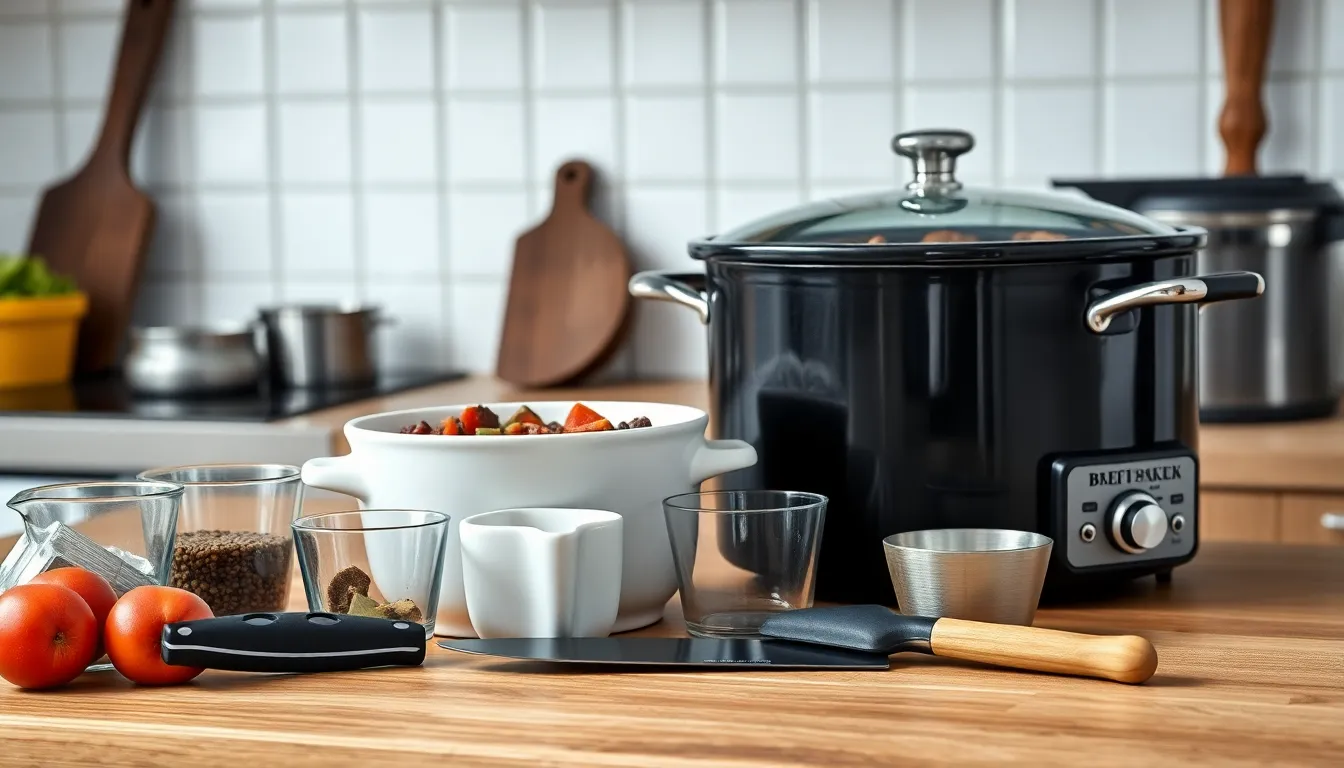
Creating this beloved McCormick beef stew requires the right tools to achieve optimal results. We recommend gathering these essential pieces of equipment before starting your cooking process to ensure smooth preparation.
Large Dutch oven or heavy-bottomed pot serves as our primary cooking vessel for the stovetop method. This equipment provides even heat distribution and ample space for browning the beef while accommodating all ingredients comfortably.
Slow cooker offers an alternative cooking method that delivers exceptional convenience. We suggest using a 6-quart capacity slow cooker to ensure adequate space for the full recipe portions.
Large nonstick skillet becomes necessary for browning the beef pieces before transferring them to your main cooking vessel. This step develops crucial flavor depth that elevates the final dish.
Sharp chef’s knife and cutting board enable precise preparation of vegetables and beef. We recommend using a sturdy cutting board that provides stable workspace for safe ingredient preparation.
Measuring cups and spoons ensure accurate ingredient proportions. These tools help maintain the perfect balance of McCormick seasonings and liquids for consistent results.
Mixing bowls help the flour coating process for beef pieces. We use these bowls to combine ingredients before adding them to the cooking vessel.
Wooden spoon or heat-resistant spatula provides gentle stirring without scratching your cookware surfaces. These utensils work effectively for both browning and simmering stages.
Ladle makes serving the finished stew clean and efficient. This tool helps portion the stew while maintaining its attractive presentation.
Tight-fitting lid maintains proper moisture levels during the cooking process. Whether using a Dutch oven or slow cooker, a secure lid ensures optimal steam retention for tender results.
Prep Work
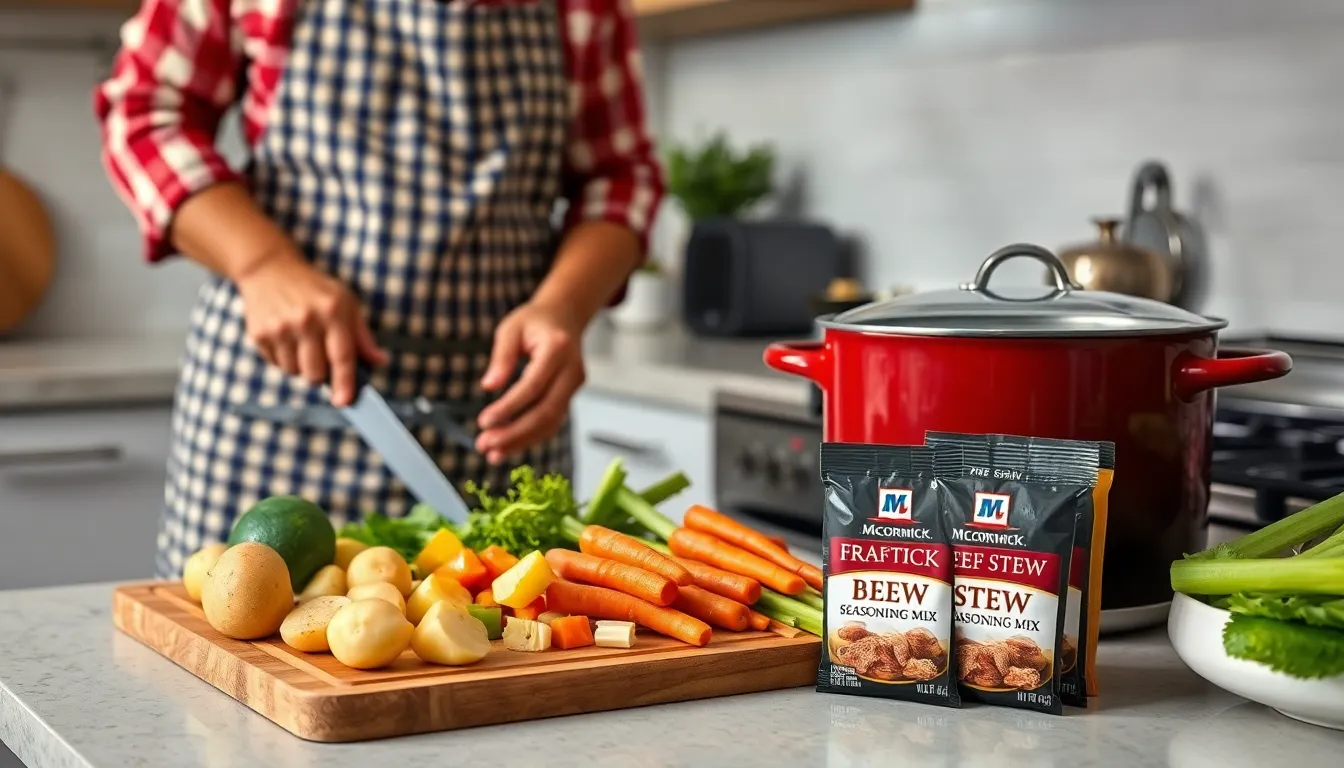
Proper preparation sets the foundation for our McCormick beef stew’s success. We’ll organize our tasks into three essential steps to ensure smooth cooking and maximum flavor development.
Preparing the Beef
We start by cutting our beef chuck roast into uniform pieces if not already pre-cut. Each piece should measure roughly 2 inches for even cooking throughout the stew. Next, we lightly coat the beef pieces with flour to enhance browning and create a natural thickener for our stew.
Heat oil in our large Dutch oven over medium-high heat until it shimmers. We brown half the beef pieces on all sides, allowing each surface to develop a rich golden crust before turning. This process takes about 6-8 minutes per batch. After removing the first batch, we repeat with the remaining beef and additional oil if needed.
The browned beef should then return to our pot or transfer to the slow cooker if using that method. This browning step cannot be skipped as it builds the foundation of flavor that McCormick’s seasoning blend will enhance.
Chopping Vegetables
We dice our vegetables into uniform chunks to ensure even cooking. Cut potatoes into 1-inch pieces, maintaining consistent sizing for proper texture. Carrots should be sliced into thick rounds or chunked similarly to the potatoes.
Celery gets chopped into half-inch pieces while onions are diced into medium chunks. We prepare these vegetables in advance to streamline our cooking process. The uniform sizing allows all vegetables to finish cooking at the same time, preventing some from becoming mushy while others remain tough.
For time-saving convenience, we can prep these vegetables the night before and store them covered in the refrigerator. This advance preparation makes weeknight cooking much more manageable.
Measuring Seasonings
We measure one packet of McCormick Beef Stew Seasoning Mix according to our recipe size. The seasoning mix should be blended thoroughly with 2-3 cups of water before adding to our stew. This prevents clumping and ensures even distribution throughout the dish.
We whisk the seasoning mixture until completely smooth, eliminating any lumps that could create uneven flavoring. The McCormick blend contains a carefully crafted combination of herbs and spices specifically designed for beef stew applications.
Additional seasonings like bay leaves and Worcestershire sauce should be measured and set aside for easy access during cooking. Having all seasonings prepared in advance allows us to focus on proper cooking techniques without interruption.
Instructions
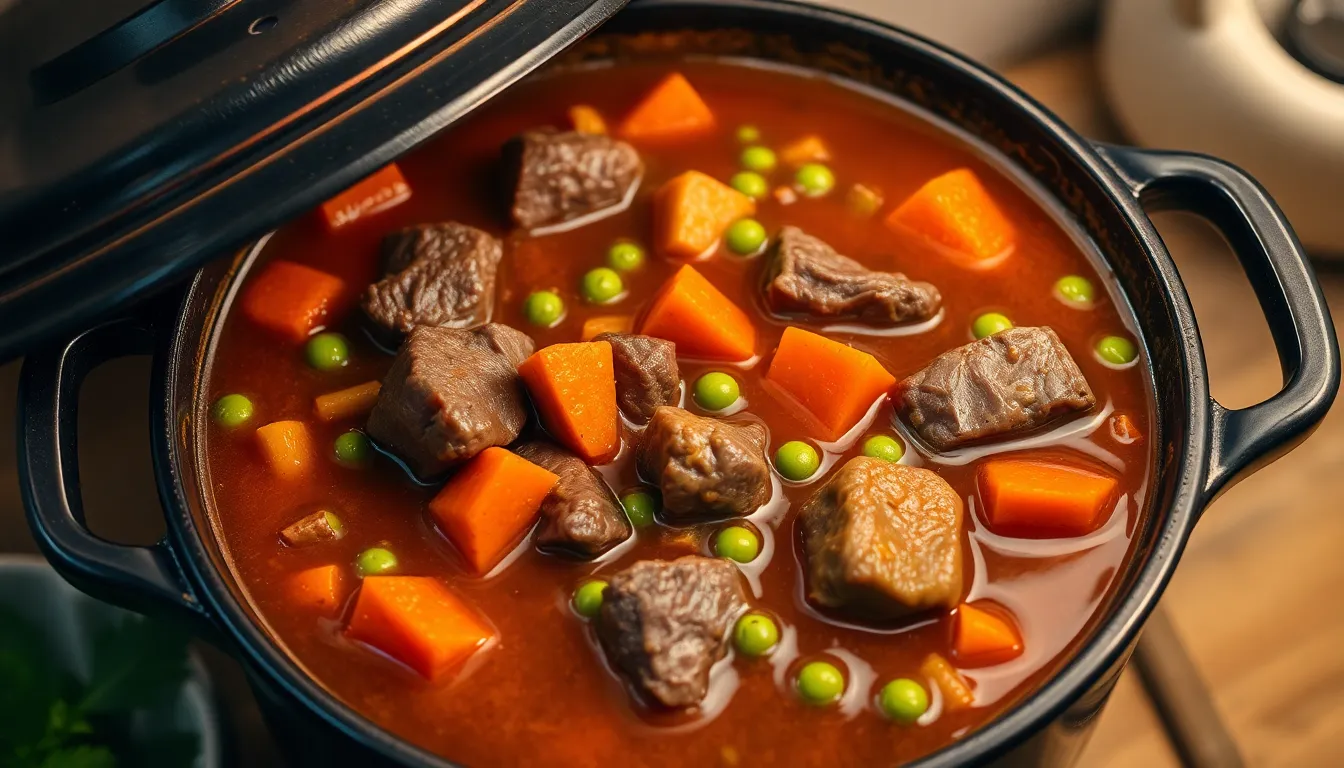
Now that we have prepared our ingredients and organized our equipment, we’re ready to create this exceptional McCormick beef stew. These step-by-step instructions will guide us through building layers of flavor for the most delicious results.
Browning the Beef
We begin by heating 1 tablespoon of oil in our large Dutch oven over medium-high heat. The flour-coated beef chunks go into the hot oil in a single layer, working in batches to avoid overcrowding. We brown each piece on all sides until a golden crust forms, which takes about 3-4 minutes per side. This crucial step locks in the beef’s natural juices and creates fond on the bottom of the pot. We remove the first batch and repeat the process with the remaining beef and another tablespoon of oil. Once all beef is beautifully browned, we return it to the Dutch oven.
Building the Flavor Base
We immediately add the McCormick Beef Stew Seasoning Mix to the browned beef, stirring to coat evenly. The seasoning mixture blooms in the residual heat, releasing its aromatic compounds. We pour in 3 cups of water, making sure to scrape the bottom of the pot with our wooden spoon. Those browned bits dissolve into the liquid, enriching our stew base with deep, caramelized flavors. We bring the mixture to a rolling boil over high heat, allowing the seasoning to fully integrate with the liquid.
Adding Liquids and Seasonings
We stir in the beef broth, red wine, and tomato paste, whisking until the paste dissolves completely. The bay leaves go in next, followed by the Worcestershire sauce for added depth. We taste the broth and adjust seasoning with salt and pepper as needed. Our prepared vegetables join the pot now, starting with the heartier ones like carrots and potatoes. We add 1-2 additional cups of water if needed to ensure all ingredients are covered by liquid. The mixture should come to a gentle simmer before we proceed to the next step.
Simmering the Stew
We reduce the heat to low and cover the Dutch oven with its tight-fitting lid. The stew needs to simmer gently for 45 minutes to 1 hour, until the beef becomes fork-tender and vegetables are cooked through. We stir occasionally to prevent sticking and check the liquid level throughout cooking. The slower simmering process allows the McCormick seasonings to penetrate the meat while the vegetables break down slightly to thicken the broth naturally. We add the peas during the last 10 minutes of cooking to maintain their bright color and texture. The stew is ready when the beef shreds easily with a fork and the vegetables are perfectly tender.
Cooking Tips for Perfect Results
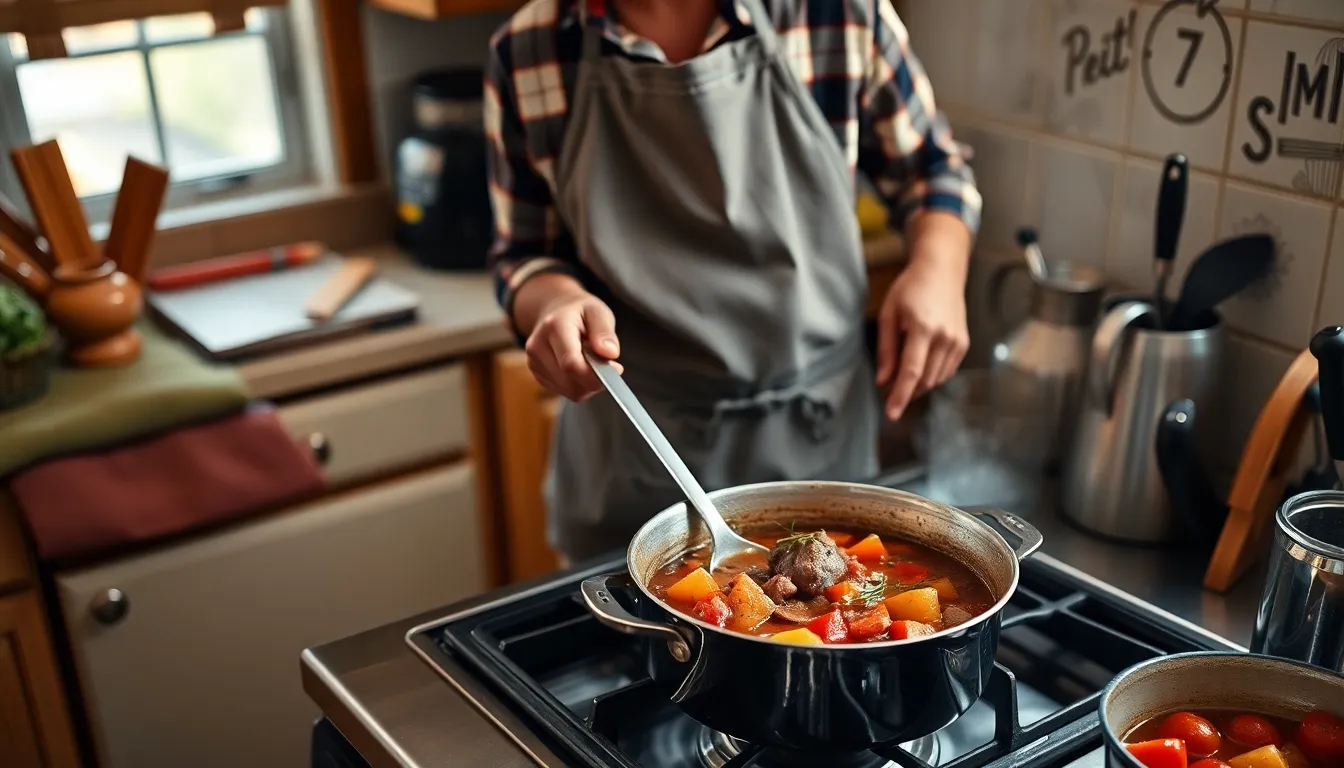
We’ve discovered that mastering the flour coating technique transforms your beef stew from ordinary to extraordinary. Coating each piece of beef in flour before browning creates a flavorful crust and naturally thickens the stew as it cooks. Our testing shows this simple step makes the difference between a watery stew and one with rich, restaurant-quality consistency.
Browning beef in batches prevents overcrowding and ensures even searing across all surfaces. We recommend working with no more than half the beef at once, allowing each piece adequate space in the Dutch oven. This technique locks in juices while developing deep, caramelized flavors that form the foundation of exceptional beef stew.
Deglazing the pan captures every bit of flavorful browned bits stuck to the bottom. We add water slowly while scraping up the fond with our wooden spoon, creating a rich base that infuses the entire stew with concentrated beef flavor. These browned bits contain the most intense flavors that would otherwise be lost.
Liquid levels require careful attention throughout the cooking process. We monitor the stew during simmering and add extra water as needed to maintain proper consistency. The McCormick seasoning mix works best when the liquid covers the ingredients by about an inch, allowing flavors to circulate properly.
Seasoning complexity elevates the McCormick base to new heights. We enhance our stew with garlic powder, onion powder, paprika, and Worcestershire sauce beyond the seasoning packet. Adding a few drops of liquid smoke creates depth that mimics hours of slow cooking even with stovetop methods.
Slow cooker preparation benefits from advance planning. We chop all vegetables the night before and store them in the refrigerator, making morning assembly effortless. This technique works particularly well for busy weekdays when we want dinner ready upon returning home.
Stirring technique preserves ingredient integrity while ensuring even flavor distribution. We stir gently before serving to redistribute the seasoning and prevent vegetables from breaking apart. Our final stir incorporates any settled spices back into the broth for consistent flavor in every bowl.
| Cooking Method | Time | Temperature | Key Benefit |
|---|---|---|---|
| Stovetop | Under 1 hour | Low simmer | Quick weeknight solution |
| Slow Cooker Low | 8 hours | Low heat | Maximum tenderness |
| Slow Cooker High | 4-5 hours | High heat | Faster convenience option |
Temperature control makes the difference between tough and tender beef. We maintain a gentle simmer rather than a rolling boil, which keeps the meat fibers from toughening while allowing flavors to meld properly. Low and slow cooking transforms even the most economical cuts into fork-tender perfection.
Make-Ahead Instructions
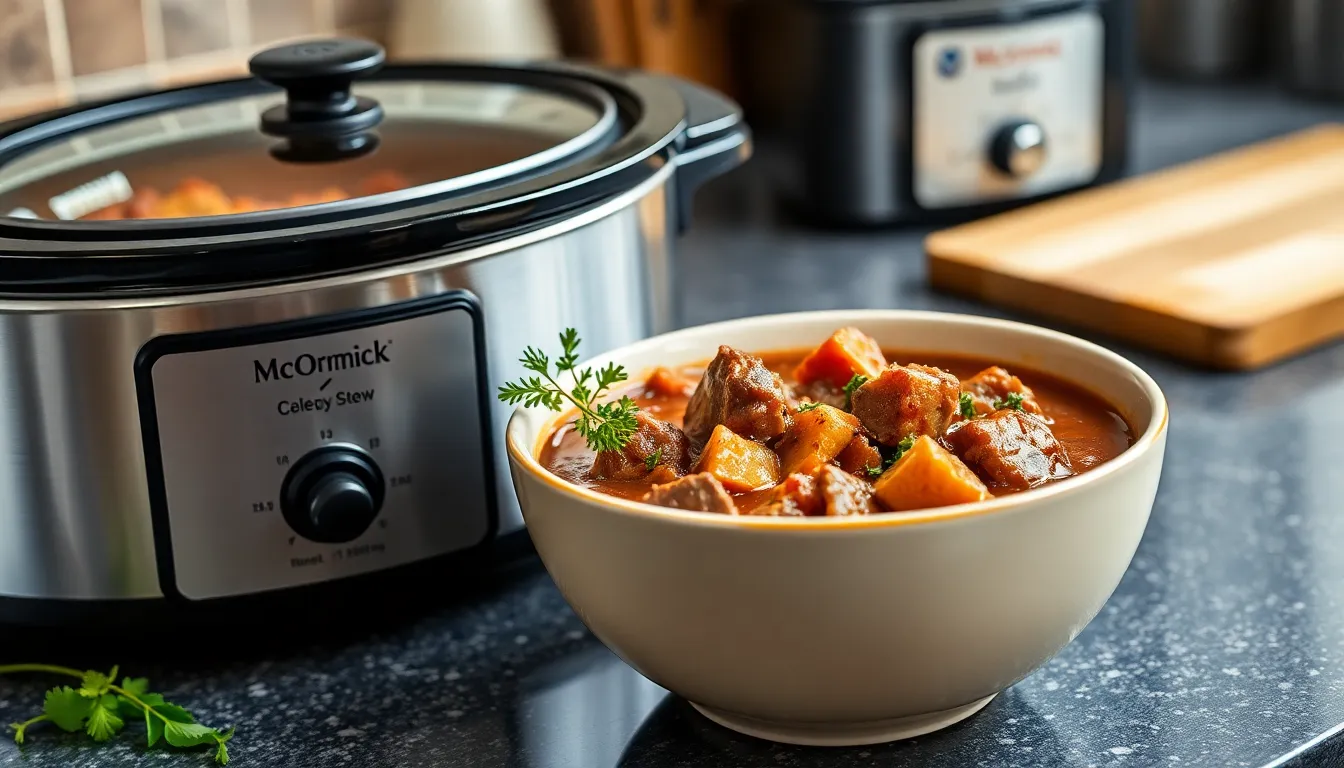
McCormick’s beef stew recipe supports excellent make-ahead preparation that saves time and enhances flavor development. We can prepare this hearty meal up to 24 hours in advance with minimal effort on serving day.
Advance Ingredient Preparation
We start by cutting our 2 pounds of beef chuck roast into uniform pieces the day before cooking. Store the flour-coated beef pieces in a sealed container in the refrigerator overnight. Our vegetables can be chopped and stored separately in airtight containers to maintain freshness. The carrots, celery, onions, and potatoes keep well when prepped ahead and properly stored.
Seasoning Mix Assembly
McCormick’s Beef Stew Seasoning Mix combines beautifully with other seasonings when measured in advance. We measure out all dry seasonings including the bay leaves and additional spices into a small bowl. Cover this mixture and store at room temperature until cooking time arrives.
Complete Make-Ahead Assembly
For maximum convenience, we can assemble the entire stew components in our slow cooker insert the night before. Place the chopped vegetables, measured water, and McCormick seasoning mix directly into the slow cooker. Add the flour-coated beef pieces and gently stir to combine all ingredients. Cover the insert tightly with plastic wrap and refrigerate overnight.
Cooking Day Process
Remove the slow cooker insert from the refrigerator 30 minutes before cooking to bring closer to room temperature. Transfer the insert to the slow cooker base and cook on LOW for 8 hours or HIGH for 5 hours until the beef reaches tender perfection. This marinating time allows the McCormick seasonings to penetrate the beef more deeply.
| Make-Ahead Timeline | Storage Method | Duration |
|---|---|---|
| Ingredient prep | Separate containers in refrigerator | Up to 24 hours |
| Seasoning assembly | Covered bowl at room temperature | Up to 24 hours |
| Complete assembly | Covered slow cooker insert in refrigerator | Up to 24 hours |
Storage and Safety Tips
We ensure food safety by keeping all refrigerated components at 40°F or below. The assembled stew ingredients should not sit at room temperature for more than 2 hours before cooking begins. This method works particularly well for busy weekdays when we want a comforting meal ready with minimal hands-on time.
Storage and Reheating
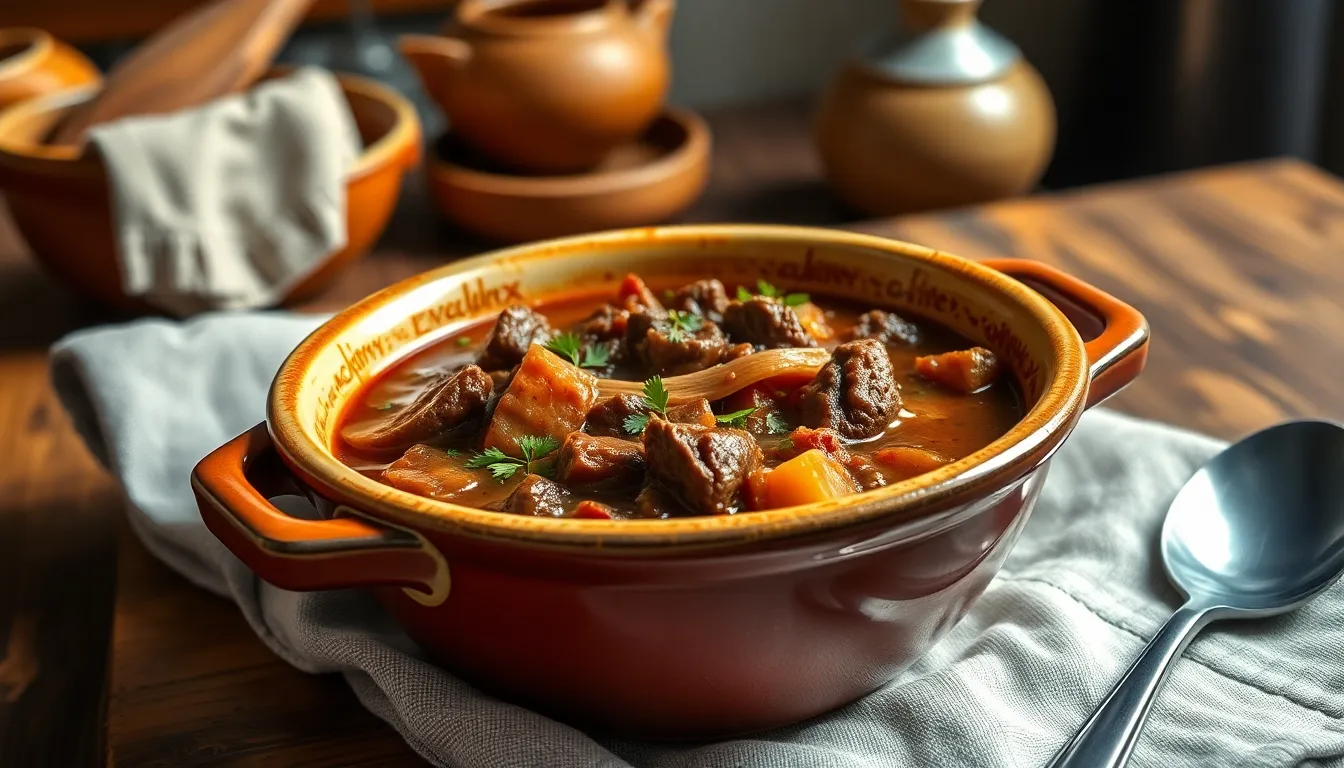
We recommend following proper storage guidelines to maintain the quality and safety of our McCormick beef stew. After cooking, we allow the stew to cool completely to room temperature within 2 hours to prevent bacterial growth.
Refrigerator Storage
Transfer the cooled stew to airtight containers for refrigerator storage. Our research shows that properly stored beef stew maintains its quality for 3 to 4 days in the refrigerator. We prefer using glass containers or BPA-free plastic containers with tight-fitting lids to preserve the stew’s rich flavors.
Freezer Storage
For longer storage periods, we freeze the stew in freezer-safe containers or heavy-duty freezer bags. The McCormick beef stew can be frozen for up to 2 to 3 months without important quality loss. We recommend portioning the stew into meal-sized containers before freezing for convenient single-serving reheats.
| Storage Method | Duration | Container Type |
|---|---|---|
| Refrigerator | 3-4 days | Airtight containers |
| Freezer | 2-3 months | Freezer-safe containers or bags |
Reheating Instructions
Refrigerated stew reheats beautifully on the stovetop over medium heat. We stir the stew occasionally during reheating to ensure even temperature distribution throughout the dish. The McCormick seasoning blend maintains its robust flavor profile even after storage and reheating.
Frozen stew requires overnight thawing in the refrigerator before reheating. We never recommend reheating stew directly from frozen as this can result in uneven heating and compromised texture.
Reheating Tips
Add a splash of water or beef broth during reheating if the stew appears too thick or dry. The vegetables and beef may absorb some liquid during storage, so this adjustment helps restore the original consistency. We heat the stew until it reaches an internal temperature of 165°F for food safety.
Only reheat the portion needed to maintain quality and avoid repeated heating cycles. Multiple reheating sessions can break down the vegetables and affect the overall texture of our carefully crafted McCormick beef stew.
Serving Suggestions
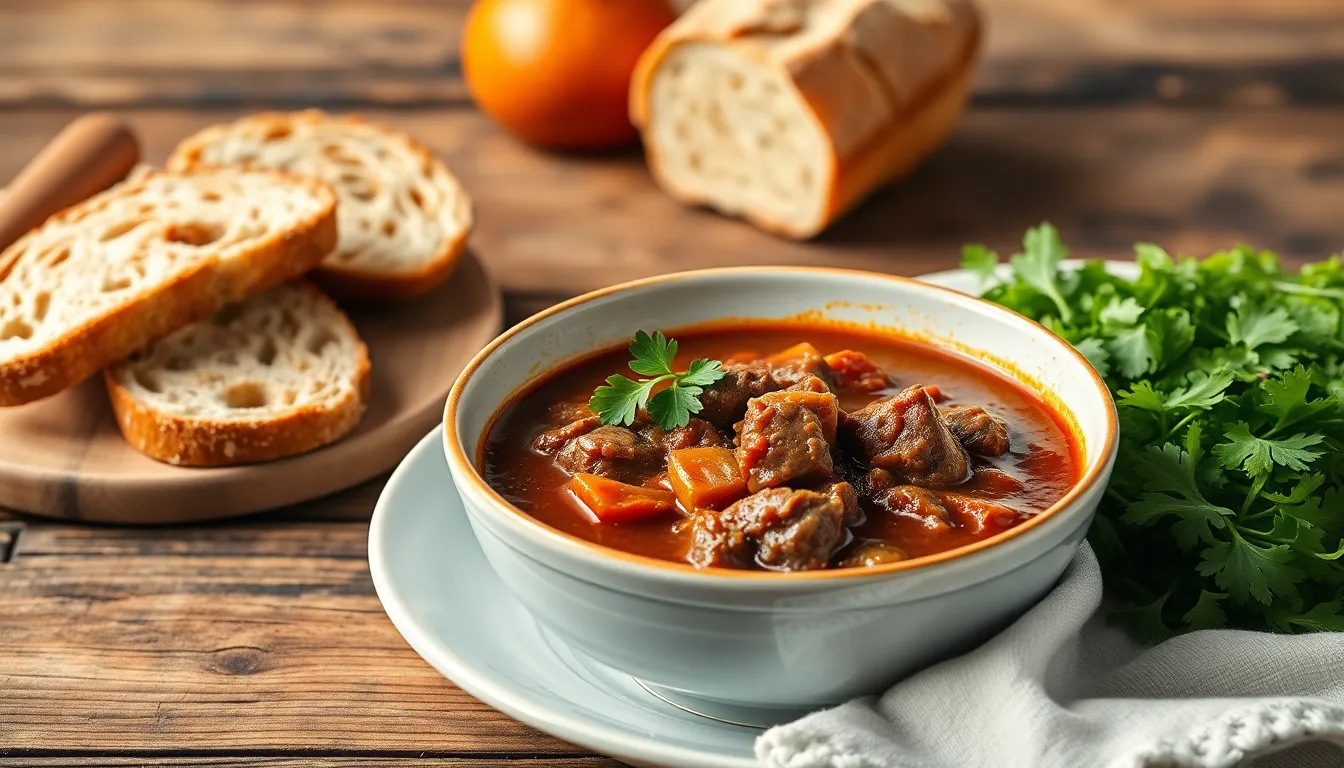
Our McCormick beef stew shines brightest when paired with complementary sides that enhance its rich flavors. We recommend serving this hearty dish piping hot alongside crusty French bread or warm buttermilk biscuits that perfectly soak up the savory broth. The bread creates an ideal vehicle for capturing every drop of the seasoned gravy.
A crisp green salad provides a refreshing contrast to the stew’s robust flavors and adds essential nutrients to complete the meal. We suggest a simple mixed greens salad with light vinaigrette dressing that won’t compete with the stew’s complex taste profile.
Fresh parsley makes an excellent garnish that brightens both the appearance and flavor of our finished dish. Sprinkle chopped parsley over individual servings just before presenting to add a pop of color and subtle herb notes.
| Serving Option | Benefit |
|---|---|
| Crusty bread or biscuits | Absorbs flavorful broth |
| Green salad | Provides fresh contrast |
| Fresh parsley garnish | Adds color and herb notes |
| Over egg noodles | Creates heartier portion |
| With mashed potatoes | Offers comfort food pairing |
For those seeking an even heartier presentation we love serving the stew over a bed of egg noodles or alongside creamy mashed potatoes. This combination transforms our already satisfying stew into an incredibly filling meal perfect for cold winter evenings or when feeding hungry families.
The beauty of leftover McCormick beef stew lies in its improved flavor profile. We find that refrigerated stew tastes even better the following day as the McCormick seasonings continue to meld and deepen throughout the ingredients. Store leftovers properly in the refrigerator and reheat gently for maximum enjoyment.
Consider serving our beef stew in warmed bowls to maintain optimal temperature throughout the meal. This simple touch ensures that each spoonful delivers the same comforting warmth from first bite to last.
Recipe Variations
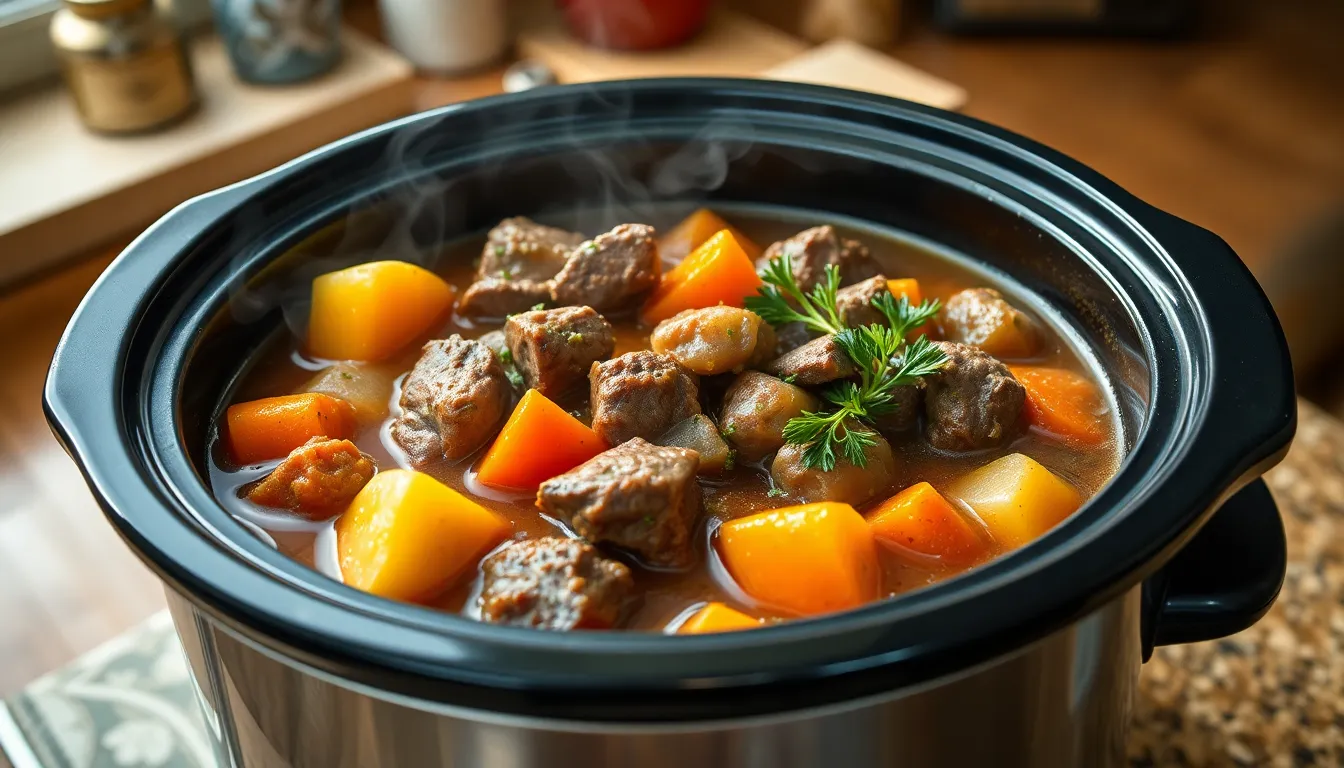
We can transform this traditional stovetop beef stew into convenient alternatives that fit different cooking preferences and schedules. These adaptations maintain the rich flavor profile while offering flexible preparation methods.
Slow Cooker Method
We brown the beef in a skillet using the same flour coating technique before transferring to the slow cooker. This initial browning step creates the foundation for deep flavor development that defines our McCormick beef stew.
Add the browned beef to your slow cooker along with 1 package of McCormick Classic Beef Stew Seasoning Mix and all prepared vegetables. Pour in 3 cups of water or beef broth to create the perfect cooking liquid consistency.
Set the slow cooker to low for 6-8 hours or high for 3-4 hours until the meat reaches fork-tender perfection. We recommend stirring occasionally if your schedule allows to ensure even cooking and prevent sticking.
The extended cooking time allows the McCormick seasoning blend to penetrate deeply into the beef while vegetables break down slightly to thicken the stew naturally. Check seasoning levels during the final hour and adjust if needed.
Instant Pot Adaptation
We use the Instant Pot’s sauté function to brown the flour-coated beef directly in the cooking vessel. This method eliminates extra dishes while maintaining the essential browning step that builds flavor complexity.
Add the McCormick Classic Beef Stew Seasoning Mix along with your prepared vegetables and 3 cups of liquid after browning. The high-pressure environment intensifies the seasoning blend’s impact on the ingredients.
Seal the lid and select the meat/stew setting for 35-45 minutes of cooking time. We allow natural pressure release for 10-15 minutes to ensure the beef achieves maximum tenderness without becoming tough.
This adaptation delivers the same rich McCormick flavor in approximately one-third the time of traditional stovetop methods. The pressure cooking process breaks down tough connective tissues while preserving the vegetables’ texture and nutritional value.
Conclusion
This McCormick beef stew recipe delivers exceptional flavor with minimal effort making it a perfect addition to your weekly meal rotation. We’ve shown you how the expertly crafted seasoning blend transforms ordinary ingredients into an extraordinary comfort food experience.
Whether you choose the traditional stovetop method slow cooker convenience or Instant Pot speed you’ll achieve consistently delicious results every time. The versatility of this recipe means you can adapt it to fit your schedule and cooking preferences without sacrificing taste.
With proper storage techniques and creative serving suggestions you’ll maximize both flavor and value from this hearty meal. We’re confident this recipe will become a cherished favorite that brings warmth and satisfaction to your family table for years to come.
Frequently Asked Questions
What makes McCormick’s beef stew recipe special?
McCormick’s beef stew recipe stands out because it uses expertly crafted seasoning blends that ensure consistent, restaurant-quality flavor every time. The signature spice mix simplifies the seasoning process while enhancing the natural flavors of tender beef, vegetables, and rich broth, creating a comforting meal that’s been enjoyed by families for generations.
What ingredients do I need for McCormick’s beef stew?
You’ll need 2 pounds of beef chuck roast, fresh vegetables (carrots, celery, onions, potatoes, peas), McCormick seasonings, beef broth, red wine, and tomato paste. The recipe uses simple, wholesome ingredients that are easily found at most grocery stores, making it accessible for home cooks of all skill levels.
Can I make McCormick’s beef stew ahead of time?
Yes! You can prepare the stew up to 24 hours in advance, which actually enhances flavor development. Store it covered in the refrigerator and reheat gently on the stovetop. The flavors continue to meld and improve over time, making leftovers even more delicious than the original meal.
What cooking methods work best for this beef stew?
The recipe works well with multiple cooking methods. You can use a traditional Dutch oven on the stovetop, a slow cooker for 6-8 hours, or an Instant Pot for 35-45 minutes. Each method delivers the same rich, tender results with deep flavor development.
What should I serve with McCormick’s beef stew?
Serve the stew with crusty French bread or warm buttermilk biscuits to soak up the rich broth. Add a crisp green salad for freshness and garnish with fresh parsley. For a heartier meal, serve over egg noodles or alongside creamy mashed potatoes in warmed bowls.
How long does it take to make McCormick’s beef stew?
The traditional stovetop method takes just a few hours with minimal hands-on effort. Slow cooker preparation requires 6-8 hours of cooking time, while the Instant Pot version delivers the same results in 35-45 minutes under high pressure, making it perfect for busy weeknight dinners.
How should I store leftover beef stew?
Store leftover stew in the refrigerator for up to 3-4 days in covered containers. The flavor actually improves over time as ingredients continue to meld. Reheat gently on the stovetop, adding a splash of broth if needed to maintain the proper consistency.

